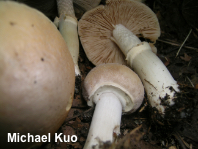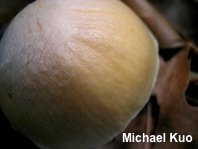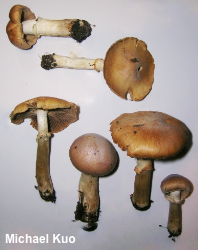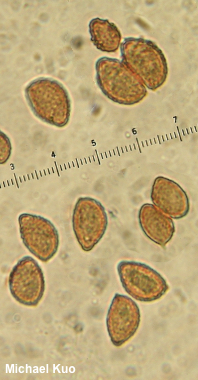| Major Groups > Gilled Mushrooms > Dark-Spored > Cortinarius > Cortinarius caperatus |

|
Cortinarius caperatus [Basidiomycota > Agaricales > Cortinariaceae > Cortinarius ... ] by Michael Kuo This beautiful and distinct mushroom can be recognized by its subtle colors, the pasted-Kleenex texture of its young cap surface, its thick, white ring, and its rusty brown spore print. It is one of only a few species of Cortinarius with a sturdy, well-developed ring rather than the cortina that gives the genus its name. Rozites caperatus is a previous name. "Rozites caperata" was an error in Latin grammar perpetuated by many field guides. Description: Ecology: Mycorrhizal with conifers, hardwoods, and bushes in the blueberry family; growing alone or, more often, gregariously; summer and fall; originally described from Europe, and widespread there; also reported from Asia; widely distributed in North America. The illustrated and described collections are from Kentucky and Michigan. Cap: 4–12 cm across; convex, becoming broadly convex, somewhat bell-shaped, or nearly flat; dry; often wrinkled; when young with a grayish to whitish, Kleenex-like coating of fibers, especially over the center; pale yellowish at first, but soon yellowish brown, often with a pale margin. Gills: Attached to the stem; close; short-gills frequent; pale at first, becoming brown or cinnamon brown; the faces sometimes somewhat mottled; covered by a white partial veil when young. Stem: 5–12 cm long; 1–2 cm thick; equal or slightly swollen at the base; dry; usually roughened or slightly shaggy near the apex; whitish or pale tan; with a thick white ring at the midsection; sometimes with a whitish covering near the base. Flesh: Whitish; unchanging when sliced. Odor: Not distinctive. Spore Print: Rusty brown. Microscopic Features: Spores 11–15 x 7–10 µm; amygdaliform; moderately verrucose; brownish golden in KOH. Basidia 30–40 x 7.5–10 µm; clavate; 4-sterigmate. Cystidia not found. Pileipellis a thin cutis of elements 2–5 µm wide, smooth or a little encrusted, hyaline to brownish in KOH, clamped; subpellis cellular. REFERENCES: (Persoon, 1796) Fries, 1838. (Fries, 1821; Saccardo, 1887; Kauffman, 1918; Smith, 1949; Smith, Smith & Weber, 1979; Phillips, 1981; Weber & Smith, 1985; Arora, 1986; Phillips, 1991/2005; Schalkwijk-Barendsen, 2019; Lincoff, 1992; Barron, 1999; Breitenbach & Kränzlin, 2000; Nonis, 2001; Peintner et al., 2002a; Peintner et al., 2002c; Roody, 2003; Garnica et al., 2005; McNeil, 2006; Kuo, 2007; Binion et al., 2008; Trudell & Ammirati, 2009; Buczacki et al., 2013; Kuo & Methven, 2014; Desjardin, Wood & Stevens, 2015; Woehrel & Light, 2017; Baroni, 2017; Gminder & Böhning, 2017; Elliott & Stephenson, 2018; Niskanen et al., 2018; Sturgeon, 2018; Læssøe & Petersen, 2019; McKnight et al., 2021.) Herb. Kuo 10010418, 09150716. This site contains no information about the edibility or toxicity of mushrooms. |
© MushroomExpert.Com |
|
Cite this page as: Kuo, M. (2021, July). Cortinarius caperatus. Retrieved from the MushroomExpert.Com Web site: http://www.mushroomexpert.com/cortinarius_caperatus.html |



